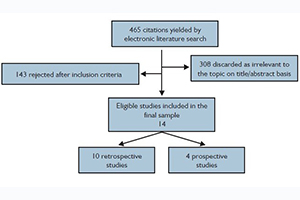Combined open and endovascular treatment of thoracoabdominal aortic pathologies: a systematic review and meta-analysis
Abstract
Background: A combined open-endovascular technique has emerged as an alternative treatment option for thoracoabdominal pathologies. However, reported experiences from various medical centers have been contradictory and heterogeneous. The aim of this study is to assess the mortality rate and various complication rates associated with this approach.
Methods: An electronic health database search was performed on all articles published up to March of 2012 describing combined open-endovascular repair of thoracoabdominal pathologies. Studies were included in the meta-analysis if they had ≥10 patients and reported the basic outcome criteria. End points of the metaanalysis were defined as primary technical success, endoprosthesis related complications, 30-day/in-hospital mortality, symptoms of spinal cord ischemia (SCI) and irreversible paraplegia, permanent renal function impairment, and other major complications.
Results: Fourteen studies were deemed eligible for this meta-analysis with a total of 528 patients (68.0% male, mean age 70.5 years). The mean follow-up period was 34.2 months. The pooled estimate for primary technical success and visceral graft patency was 95.4% and 96.5% respectively. An endoleak developed in 106 (21.1%) patients in whom both stages had been completed. The pooled rate for symptomatic SCI was 7.0% and for irreversible paraplegia 4.4%. The pooled proportion for permanent renal failure was 7.0% and for mesenteric ischemia 4.5%. Prolonged respiratory support and cardiac complications were observed in a pooled rate of 7.8% and 4.6% respectively. The meta-analysis for 30-day/in-hospital mortality revealed a pooled rate of 14.3%.
Conclusions: Although the hybrid technique for thoracoabdominal aortic pathology provides a less invasive approach, the technique is still associated with a considerable morbidity and mortality rates. High risk patients unfit to withstand open repair, are equally likely to suffer significant complications with the hybrid procedure. The choice of the optimal treatment strategy for thoracoabdominal pathologies should be carefully made on a patient to patient basis, assessing the clinical fitness and the anatomical suitability of each patient. The hybrid approach should be reserved for high volume centers with accumulated experience and high standards of perioperative management.
Cover






